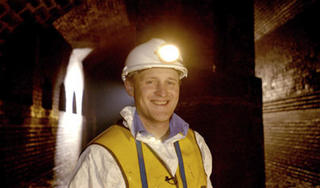The Great Stink

Nineteenth Century London stank, a stench that could be smelt over 60 miles away, but this was the least of the capital’s problems - the sewage from over 2 million Londoners flowed into the Thames daily; the same river from which the cities inhabitants drew their unfiltered drinking water! As a result Cholera and other waterborne diseases were killing over 6000 people per year.
The towns folk hung sackcloth soaked in deodorising chemicals over their windows just to make the air in their homes breathable. When walking the streets the ground would often give way - people would fall into badly constructed cesspits, drowning in their neighbours faeces.
What’s more the methane gas, created by these cesspits and the build up of sewage, regularly exploded killing any unfortunate passers-by. In these fatally unhygienic conditions the average life expectancy of a Victorian working class man was just 18.
These conditions were horrific but politicians failed to act. That is until one hot summers day the putrid stench of the Thames drove the countries lawmakers from the Parliament buildings coughing and vomiting. The press called it The Great Stink.
This is the story of how the man they elected to sort out this catastrophe, Joseph Bazalgette, built what was described as 'the most wonderful work of modern times' – the London sewage system.
This colossal undertaking saved the lives of thousands, extinguished cholera epidemics and was the largest, most impressive, feat of engineering the world had ever seen. Bazalgette’s creation was the envy of cities across the globe.

0 Comments:
Post a Comment
<< Home